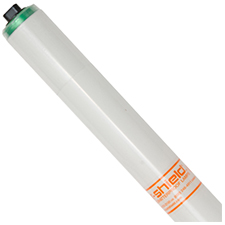
Protective Coatings Bring Multiple Benefits to LEDs
Chuck Ross
Tube lamps have been a go-to for decades and, while the latest LED fixtures often incorporate integrated lighting elements – in other words, no separate lamps – millions of troffer fixtures initially designed for fluorescent technology are still in service around the globe. LED replacement lamps designed for these fixtures must meet the same safety standards applied to more traditional lighting products, based on where they’re being used. And it turns out the plastic coatings used to meet these requirements for LEDs can have added benefits, beyond protecting nearby occupants from the dangers of shattered glass.
Shatter-resistant lamps are a must in a range of locations where fixtures might be at risk from accidental damage or vandalism. These include schools, correctional facilities, commercial kitchens and healthcare facilities, among other settings. In these applications, contractors and facilities personnel use lamps that have been treated with a tightly adhered plastic coating that will hold glass shards in place in case of breakage.
For LEDs, beyond the safety considerations, these coatings also can help ensure longer lifespans. With their sensitive electronics, these lamps can be more prone to damage due to moisture infiltration than fluorescent models. Adding a coating can seal out moisture to keep internal operations dry. As a result, lights can be expected to keep shining for the full length of their projected lifespan, which could be a decade or more.
Once fixtures are ready for replacement, owners and facilities managers are likely to opt for dedicated LED models, with the lighting elements integrated directly into the fixtures, themselves. Here, too, manufacturers are addressing the issue of moisture infiltration by using silicone coatings to seal internal circuitry. Though the coatings go directly over LED light sources, they’re engineered not to yellow with age or otherwise affect a fixture’s lighting characteristics. In addition to moisture protection, the silicone also guards against environmental contaminants and provides thermal insulation from both extreme heat and cold.
Shatter-resistant lamps are a must in a range of locations where fixtures might be at risk from accidental damage or vandalism. These include schools, correctional facilities, commercial kitchens and healthcare facilities, among other settings. In these applications, contractors and facilities personnel use lamps that have been treated with a tightly adhered plastic coating that will hold glass shards in place in case of breakage.
For LEDs, beyond the safety considerations, these coatings also can help ensure longer lifespans. With their sensitive electronics, these lamps can be more prone to damage due to moisture infiltration than fluorescent models. Adding a coating can seal out moisture to keep internal operations dry. As a result, lights can be expected to keep shining for the full length of their projected lifespan, which could be a decade or more.
Once fixtures are ready for replacement, owners and facilities managers are likely to opt for dedicated LED models, with the lighting elements integrated directly into the fixtures, themselves. Here, too, manufacturers are addressing the issue of moisture infiltration by using silicone coatings to seal internal circuitry. Though the coatings go directly over LED light sources, they’re engineered not to yellow with age or otherwise affect a fixture’s lighting characteristics. In addition to moisture protection, the silicone also guards against environmental contaminants and provides thermal insulation from both extreme heat and cold.
Photo courtesy of Shat-R-Shield



